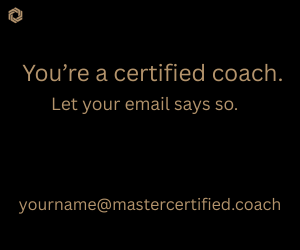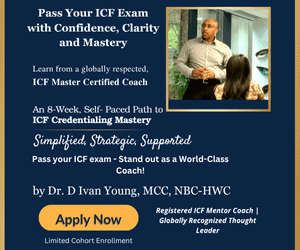Ever wish you could time travel? If I could go back to the beginning of my journey building coaching programs, there are a few key lessons I’d want to share with myself, especially when it comes to earning student trust and building long-term loyalty. The kind of insight that would help me seal the deal with potential students and reassure organizational leaders and teams that were uncertain and resistant. So, if I could go back in time now to give myself advice, these five lessons would be at the top of my list.
How to Build a Coaching Education Program That Keeps Them Coming Back
1. Don’t Reinvent the Wheel
When building a coaching program from the ground up, a trusted structure is essential. Without it, you risk losing both clarity and credibility. One of the most important decisions I made early on was to align my program with a recognized industry standard.
For me, that standard was ICF accreditation. ICF’s process and Core Competencies provided secure stepping stones to build my program on. Instead of constantly chasing new students at every level, I could design a program that supports coaches throughout their entire development journey — from ACC to PCC to MCC.
That shift changed everything. It allowed me to stop thinking in terms of one-off enrollments and start thinking about lifetime loyalty.
2. Don’t Wait to Build Your Relationship Database
It’s easy to think you’ll get organized later, once the business grows, once you have more contacts or students, once you “need” an organizational tool. I used to think that, too. But the truth is, by the time you feel the need, you’ve already missed opportunities.
A simple, organized database of your relationships — potential students, corporate contacts, mentors, past clients — becomes one of your most powerful tools over time. Once I committed to building and maintaining a database, I finally had a way to stay in touch, follow up meaningfully, and nurture trust over time.
Eventually, I made the leap to invest in a CRM (Customer Relationship Management) tool that could automate some of that communication, including welcome sequences, re-engagement emails, invitations to new offerings, and more. But the real value wasn’t the software. It was the discipline of tracking and tending to the relationships I had already built.
When I reflect on all the people I worked with early in my career, people who would probably be some of my most loyal students today, I wish I had kept better track of those connections.
3. Offer a No-Risk First Step
Early in my career, I realized that even the most interested students have hesitations. They might be intrigued by the promise of coaching but unsure if this program is the right fit or if coaching itself will be effective in their environment.
That’s why I started offering a simple guarantee: if they weren’t satisfied after the first module, they could get their money back. No pressure, no risk.
Removing that one barrier — the fear of wasting time or money — made a big difference. It’s challenging for potential students to fully understand the value of your program. This offer gives you the chance to earn their trust by showing the value of the program in action.
I also offer training for companies building their coaching cultures. This approach works well with skeptical company leaders who want a quick, three-day training instead of the comprehensive, 15-day program I offer. Rather than debate them, I offer a glimpse. One module. Full refund if it doesn’t resonate for their team.
Once they’ve experienced the first step and can see real engagement and early wins, they’re far more open to continuing the journey.
4. Take a Measured Approach
Whether you’re working with a company building their coaching culture or supporting individual students, the start of any learning journey can feel uncertain. People don’t know what to expect, and often, they’re not sure why they need what you’re offering.
Early in my career, I made the mistake of jumping in too fast. I wanted to show my value right away. However, I quickly learned that rushing in doesn’t accelerate learning; it actually undermines it.
Now, I’ve learned to start with connection. I take the time to build trust using my REACH framework, where Rapport is the first step. Before I teach anything, I focus on creating a safe and open space where people feel seen and heard.
This shift has made a measurable difference, creating stronger buy-in, comprehension, and retention of information.
5. Share a Clear Roadmap
One of the most powerful ways to build trust early on is to show them where they are headed, demonstrating that you have a clear and intentional process.
Over the years, I developed a simple but flexible structure for my program that helps students understand what to expect and how each phase connects to the next. I call it the REACH framework: Rapport, Explore, Action, Clarify, Honor.
This structure works across a wide range of contexts, whether I’m training in hospitals, warehouses, education departments, or private cohorts. It helps students orient themselves and illustrates how the program will roll out, what competencies will be covered, and how it will translate to real impact.
I’ll often say something like, “Here are the ten checks I’ll walk your team through to make sure these skills actually show up in your environment.” This kind of clarity builds confidence and reinforces that you’re leading a well-designed process.
Start Building Loyalty Today
These five lessons have become cornerstones in the way I approach coach education, not just in how I design programs but also in how I build relationships with every student and stakeholder I serve. I only wish I had embraced them sooner.
If you’re building your own coaching program or refining one that’s already running, don’t wait to put these principles into practice. The earlier you lay these foundations, the more lasting your impact.
Because the best coaching programs don’t just deliver content — they build confidence, connection, and loyalty that lasts a lifetime.
Learn more about how ICF’s coaching education standards can give you a competitive edge.
Disclaimer
The views and opinions expressed in guest posts featured on this blog are those of the author and do not necessarily reflect the opinions and views of the International Coach Federation (ICF). The publication of a guest post on the ICF Blog does not equate to an ICF endorsement or guarantee of the products or services provided by the author.
Additionally, for the purpose of full disclosure and as a disclaimer of liability, this content was possibly generated using the assistance of an AI program. Its contents, either in whole or in part, have been reviewed and revised by a human. Nevertheless, the reader/user is responsible for verifying the information presented and should not rely upon this article or post as providing any specific professional advice or counsel. Its contents are provided “as is,” and ICF makes no representations or warranties as to its accuracy or completeness and to the fullest extent permitted by applicable law specifically disclaims any and all liability for any damages or injuries resulting from use of or reliance thereupon.
Authors
Post Type
Blog
Audience Type
Coach Educators
Topic
Coach Educator Essentials, Discover - Your Coaching Career
Related Posts
The Coaching Trap: When Empathy Becomes Exhaustion
Prepare yourself for the fact that this will not be about you…
Your Guide to Preparing for the ACC Exam
Much like a smartphone upgrade that introduces improvements for a smoother user…
How Coaching Is Driving Inclusion Around the Globe: Lessons from Local ICF Chapters
When a group of mothers in Kazakhstan, many of whom had never…








